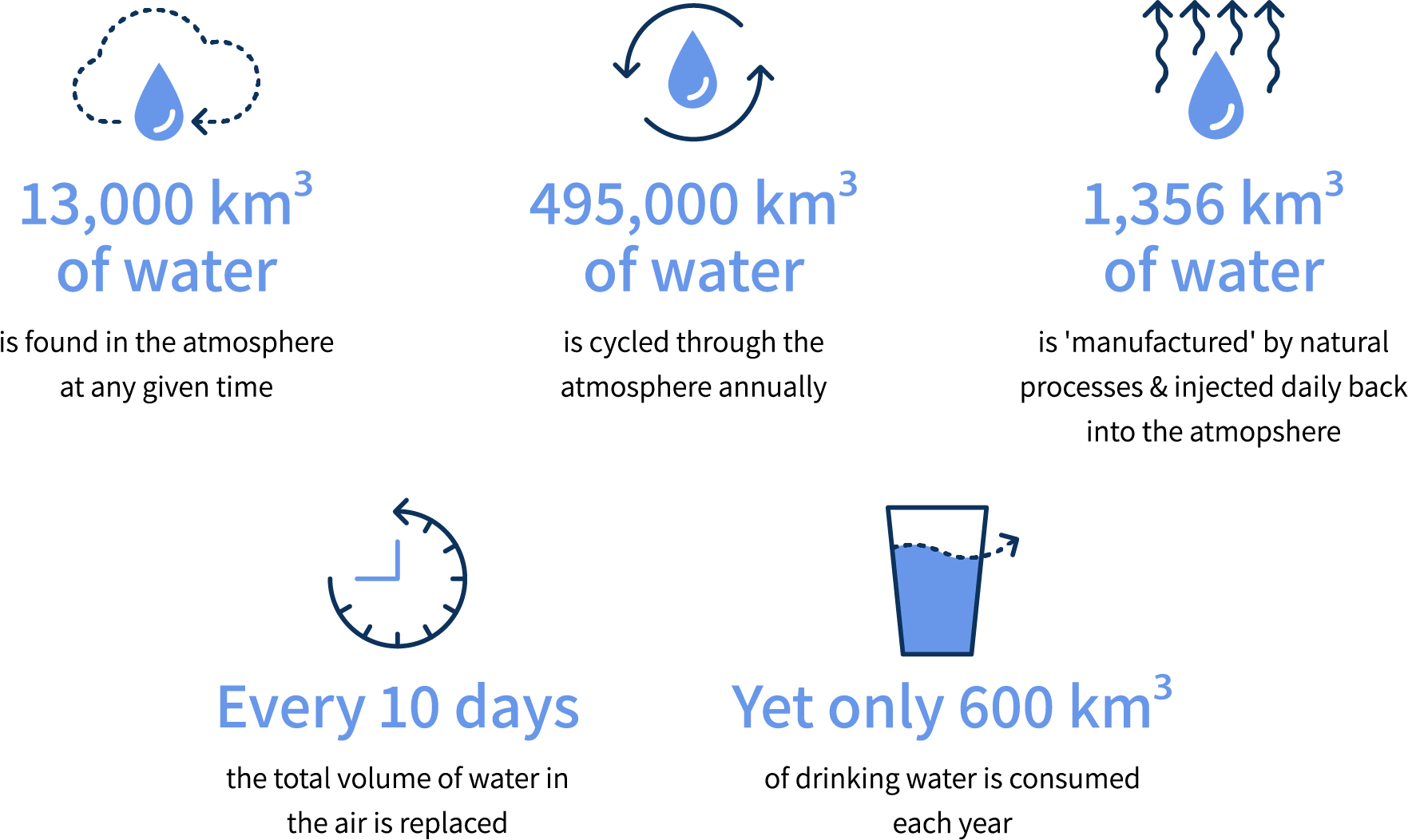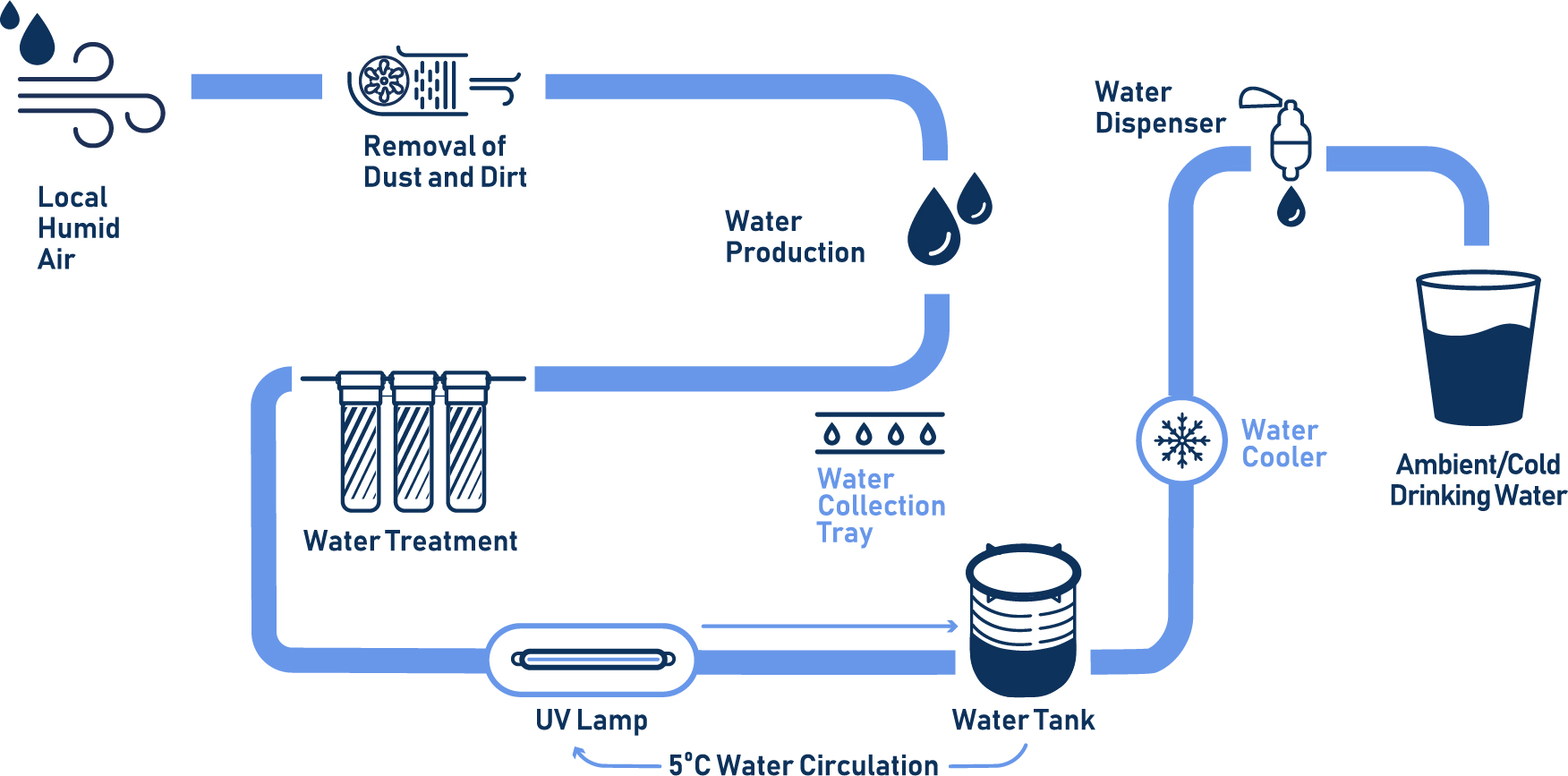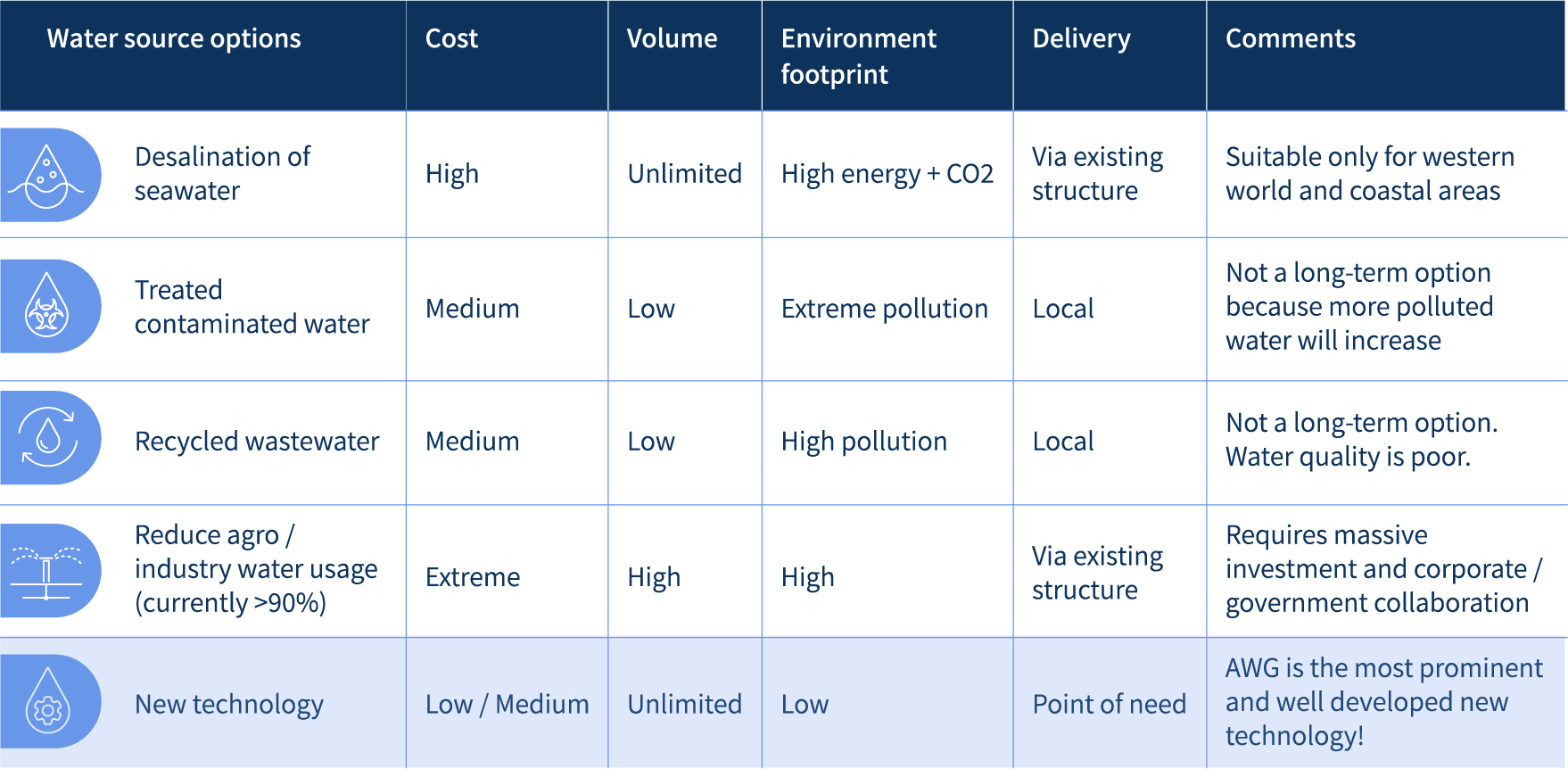Home › Blog › Drinking Water From the Air

About 97.5% of the Earth’s water is too salty to drink, so it is remarkable that we actually breathe the closest source for potable water: the air!
Crisis – Drinking water scarcity is a global problem that has the world scrambling for cost-effective and environmentally-friendly, point-of-use solutions that can reach people wherever they are, without complicated logistics and transportation. (Ref. & )
The primary goal of sustainability is considered to be reaching a solution where water systems should “provide adequate water quantity and appropriate drinking water quality for a given need, without compromising the future ability to provide this capacity and quality.”
To understand this in the context of drinking water, it’s important to remember that about 97.5% of the Earth’s water is stored in oceans and is too salty to drink. The global water delivery infrastructure is old, leaky, and rusty. Climate change is causing our lakes to dry up and disappear.
So why have we not been using the most abundant source of potable water in existence: the humidity in the air?
It’s all around us, it’s free and it’s always fresh!

Let’s look at it this way: if, somehow, the entire world switched over to drinking air-source water, we would only be drawing a minute portion of the water that is added naturally on any given day, and barely one ten-thousandth of the total.
This means that the air around us provides us with a fully renewable, practically unlimited resource that’s available to us to harvest – without compromising sustainability.

Among the most exciting solutions to the water scarcity problem to emerge is the field of Atmospheric Water Generation (AWG), more popularly known as “Water-from-Air” technologies.
In terms of sustainability, the challenge posed to AWG is to collect the water in large enough quantities, with as little energy as possible, and make it fresh, clean, and accessible enough to supply communities in times of water stress.
AWG technologies are truly groundbreaking. They manage to capture moisture from the air, filter out any dirt and extract the water from the air’s humidity (they are most efficient when humidity levels are above 35%). AWG’s eliminate heavy metals, particles, biological organism, organic compounds (VOC, SVOC) remaining in the harvested water, and then add minerals that are essential to the water’s “drinkability”, such as calcium and magnesium – (water without proper mineral balance doesn’t taste “natural”). AWG technologies then cool, circulate and maintain water quality at a low temperature of 5° – 7° Celsius. The water is kept continuously fresh and made available directly at points of need. This is a huge change when we compare it to other water sources.

The more effective and efficient the AWG technologies are, the safer people will be worldwide. In remote and undeveloped communities, fewer people will suffer illness and death caused by contaminated groundwater. It’s vital to remember that in much of the third world, contaminated or polluted water is the leading cause of death in children.
According to a World Health Organization (Ref. & ) study , one-third of the world’s population lacks access to safe drinking water. This translates in real terms to 3.2 billion people around the world who still lack safely managed drinking water, including 785 million people without basic drinking water. And that number is heavily skewed in poorer countries which are already locked into cycles of drought and rising sea levels.
Developing countries almost universally suffer from the worst water delivery problems. Along with simple scarcity, the tremendous shifts in population away from rural areas into cities have exaggerated the problem. The water delivery systems simply cannot cope with the demand for fresh drinking water without massive investment in infrastructure, which has not been done. As a result, primary delivery systems suffer from decaying pipes adding toxic chemicals into the water, polluted sources, breakages, and leaks. This has two negative effects. Firstly, there is not enough water to sustain the population levels, and, secondly, the water that is being delivered is poor in quality and may even be dangerous to our health.

With AWG working around the world, people will have access to fresh, clean, and safe drinking water created from the humidity in the air around us.
AWG eliminates the need for infrastructure and water piping – no dangers of chemicals, pathogens, and pesticides that may be polluting their groundwater; just plug it and drink.
AWG provides a mobile and convenient solution – it allows the creation of drinking water at the right where you need it. No need for transportation and storage – AWG requires electrical source only and can be loaded on trailers to provide drinking water from anywhere needed.
AWG create a new source of drinking water – every new drop is an extra water source which comes fresh and clear from the air around us, without using existing water sources!
AWG will dramatically reduce the use of plastic containers now widely used to deliver and store drinking water, thus provide a sustainable solution. The use of plastic bottles represents one of the main factors contributing to climate change and disease. Plastic has multiple deleterious side effects. It can cause lower drinking water quality directly by releasing toxic chemicals into the bottled water. After use, it is discarded and becomes a source of environmental pollution, garbage disposal problems, and a significant cause of the ocean water poisoning that is leading to declines in fish populations.
In summary, a viable solution for providing clean drinking water is an essential, if not THE most important, consideration for the future of ourselves and our children. Furthermore, producing drinking water at the point consumption reduces the global carbon footprint by minimizing transportation. Creating a new source of drinking water from the air efficiently makes AWG the most promising and, in fact, the only practical means available right now to achieve sustainable water.
Producing water from air is a process that requires energy. Depending on the need’s location and duration, AWG systems will draw on the most efficient available energy source. Increasingly, most systems soon will operate on a renewable source, such as solar, wind or hydro-energy.
A large AWG unit stationed in an emergency zone following a natural disaster may be powered by a generator, but a permanent unit in a remote location would rely on a renewable source, which is also the most environmentally-friendly option.
Many locales are ideal for larger AWG installs, such as university and school campuses, army bases, combat units and defense forces, large factories, municipal parks, resorts, emergency response teams, villages in rural areas, RV and private vehicles, marine vessels etc., where the primary need is for drinking water in peak times. AWG works 24 hours a day, producing up to thousands of fresh drinking water and storing them for delivery when needed.
In a typical office building, water coolers currently rely on 5-gallon (19 liter) plastic bottles which have to be delivered, stored and switched almost daily. In comparison, a single large AWG unit on the roof of a building office tower could provide sufficient fresh drinking water to all the building’s workers. Alternately, individual units distributed throughout a shared office building will deliver up to 23 liters (7 gallons) at individual points wherever the water is needed.
At home, a smaller AWG plugged into domestic power will produce on average 22 liters (6 gallons) of fresh water every day from the air, enough to sustain a family of four for their drinking needs.

With companies globally active in this dynamic market, and with about a few of them gaining major recognition, we can expect Atmospheric Water Generation Systems to become a fixture wherever people get thirsty and require access to fresh, clean drinking water. AWG technology has the greatest potential of all current methods for reducing drinking water stress in all countries, both developing and developed, currently and in the immediate future.